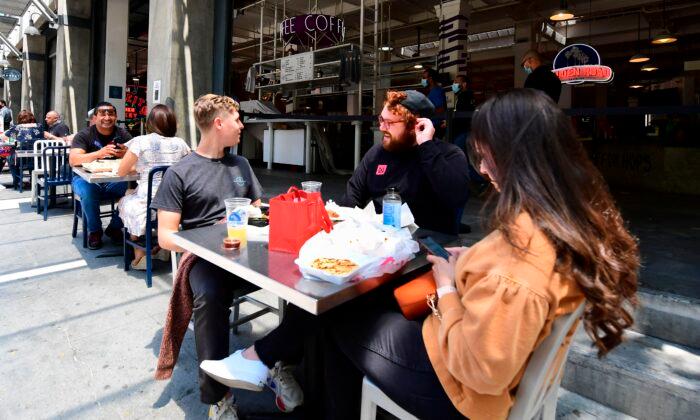Major swaths of the U.S. economy are coming back to life, with 4.8 million jobs added in June as states gradually ease restrictions imposed on businesses in response to the CCP virus pandemic.
Trump also touted the rise in consumer confidence, retail sales, and the number of workers re-entering the labor force.
“The crisis is being handled,” he said.
He said the situation with COVID-19, the disease caused by the CCP virus, is “getting under control,” although he acknowledged that there are areas where it has “flared up.”
“We are putting out the fires,” he said.
Unemployment dropped to 11.1 percent from 13.3 percent the month before.
The shutdowns sent unemployment on a roller coaster ride as the rate spiked to 14.7 percent in April from 3.5 percent in February. Since then, the economy has been recovering.
The measurement of the unemployment rate continued to be biased lower by people incorrectly misclassifying themselves as being “employed but absent from work” last month. The unemployment rate would have been 12.1 percent without the misclassification problem, the BLS said.
Hiring in June was boosted by the typically low-paying leisure and hospitality industry, which added 2.1 million jobs, accounting for about two-fifths of the gains in payrolls. The return of these workers pushed down average wages by 1.2 percent in June.
“We couldn’t be more pleased with the results today. Between this month and last month, that’s about 8 million jobs, about 8 million people we’ve put back to work,” Treasury Secretary Steven Mnuchin said. He said the administration’s work wouldn’t be done until every person who lost their job amid the shutdowns regains employment.
The unemployment rate dropped the most for Hispanics (to 14.5 percent from 17.6 percent), then whites (to 10.1 percent from 12.4 percent), followed by blacks (to 15.4 percent from 16.8 percent) and Asians (to 13.8 percent from 15 percent).
“There’s still a lot of hardship, and a lot of heartbreak in these numbers,” said Larry Kudlow, Trump’s economic adviser. “I understand that. The economy is on its way back, but we have a ways to go.”
He emphasized, though, that the economists are predicting a major recovery in the third quarter.
Regarding the rising numbers of virus cases in some areas, Mnuchin said the states are “acting appropriately” by pausing the reopening of “more contagious” settings such as bars and gyms.
“We think there is the right balance, and we’re working with the states on the health issues and the economic issues,” he said.
The majority of the spike in virus cases in the past week has been concentrated in some 60 counties, largely in Texas, California, Florida, and Arizona.
Average hourly earnings at private companies fell 1.2 percent to $29.39 in June. For rank-and-file workers specifically, hourly earnings declined 0.9 percent to $24.74.
The reason wasn’t so much that employers imposed pay cuts. Rather, the workers who were rehired in June at bars, restaurants, and other such establishments disproportionately work in lower-paying occupations. That trend pulled down average wages for the month.
“The decline reflects the extent to which June’s job gains were skewed toward lower-wage, lower-hour industry groups, such as retail trade and leisure and hospitality services,” said Richard Moody, chief economist at Regions Financial.
U.S. stocks rallied on the employment data. The dollar was steady against a basket of currencies. U.S. Treasury yields fell.
In a separate report on July 2, the Labor Department said initial claims for state unemployment benefits fell 55,000 to a seasonally adjusted 1.427 million for the week ended June 27. Though claims have declined from a record 6.867 million in late March, progress has been slow.
The claims report also showed the number of people receiving benefits after an initial week of aid rose 59,000 to 19.290 million in the week ending June 20. These so-called continued claims, which are reported with a one-week lag, have dropped from a record 24.912 million in early May.
There were 31.5 million people collecting unemployment checks in mid-June. Of those, over 17 million collected the standard state benefits and nearly 13 million the special pandemic-related benefits.
Some big bank analysts stroke a gloomy note on the report, wary of new restrictions that states may impose in response to virus case spikes.
“Remember that the (June jobs) data are capturing the data from the middle of May through the middle of June, given the survey period,” economists at Bank of America Global Research cautioned. “It captures the state of the labor market before the economy was hit by the rise in virus cases in the Sun Belt.”
Jay Bryson, chief economist at Wells Fargo Securities, voiced similar worries.
“With the number of COVID-19 cases accelerating and some states delaying re-opening or imposing new restrictions, we are concerned that a significant number of individuals may become furloughed again,“ he said in a research report. “The outsized gains in payrolls that were registered in May and June likely won’t be repeated in the next few months.”





